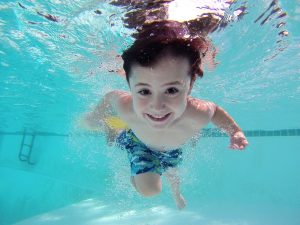
(Canada Swim School, November, 2017)
Swimming success relies on how efficiently you can move through the water, and it involves breaking bad habits that come naturally when learning how to swim. To a degree, the amount of bone/muscle/fat in your body will influence your body in the water – fat floats easier than muscle, for example – but an error in your body posture while swimming is usually due to bad technique.
The following is a collection of the most common swimming posture errors and some solutions on how to fix them, especially if you’re just learning how to swim.
Upper Body Position
The reason beginner swimmers struggle in the water is due to an ineffective breathing motion. Breathing while swimming is connected directly to upper body form, and if you strike the right balance you’ll find everything becomes easier. If you find that you or your child is having problems breathing while swimming, it may be related to one of two things: keeping the spine aligned, and what’s known as “crossing-over.”
During a crossover, one or both hands will cross the centre line of the body as they enter the water, when they should remain straight ahead. This affects balance in the water and forces the swimmer to compensate to maintain a straight line.
As your hand enters the water during front crawl, it should be perfectly in line with your shoulder. This helps you maintain a straight line and enables you to grab hold of the water and propel yourself forwards. Doing this improperly can throw off your alignment and make it difficult to breathe. On top of that, excess head motion as you try to compensate further distorts the body position, increases resistance, and slows swimming speed. As you can see, this is all connected.
What can we do about it? Focus on your middle finger of each hand pointing straight ahead as it enters the water and extends forward.
Lower Body Position
Your body can act just like a see-saw when swimming: when one end goes too low, the other tends to go to high. If your head is high in the water, your feet will tend to go low, unless you kick a lot to keep them up. This is a very common problem, even with athletic swimmers.
Your upper body will tend to stay high in the water because of air in the lungs, helping that part of the body to float like a filled balloon, and because you work to keep your head close enough to the surface of the water to get air when you need to take a breath.
If your legs are too low, they will increase your frontal surface area and slow you down. The way to solve this is to be conscious of how flat your body is when swimming, since your legs will want to go down starting at the hips.
Another big problem we see in both beginners and professionals: swimmers that bend their knees too much while kicking. This creates large amounts of drag and contributes to the number one reason for a swimmer’s legs to sink low in the water. Instead of kicking from the knee you should kick from the hip with a relatively straight leg. It’s okay if there’s a slight bend in the knee, but as long as you’re kicking from the hips it will also help you maintain that flat posture. This will make everything from forward-momentum to breathing easier.
Tips To Start Today
 It sounds like a lot to think about while learning how to swim, but it will soon become second nature, especially with regular practice. This is why it’s important to take it a bit at a time, and the earlier you can start the better.
It sounds like a lot to think about while learning how to swim, but it will soon become second nature, especially with regular practice. This is why it’s important to take it a bit at a time, and the earlier you can start the better.
Remember, you want your child to think that being in the water is fun, while being in the pool with you is wonderful. Once they begin structured lessons, your child will learn fairly quickly in order to be more comfortable in the water.
At CSS, we reinforce the right technique at the right time to help your child reach each milestone of success quickly. As your child progresses, their strengths and weaknesses will be continually evaluated to help modify their lessons and support them to become a confident and capable swimmer quickly.
To book a private lesson, or find a Canada Swim School near you, contact us at: http://canadaswimschool.com/contact.
See you at the pool!


